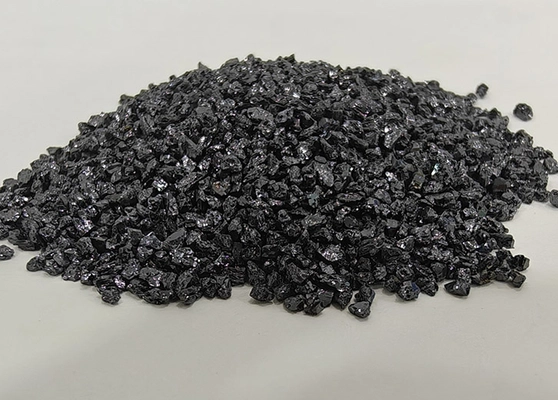Brown Fused Alumina (BFA) is a synthetic abrasive material made by melting high-quality bauxite in an electric arc furnace at over 2000°C. It is characterized by its high hardness, thermal resistance, good toughness, and moderate purity. With a Mohs hardness of about 9, and a typical alumina (Al₂O₃) content around 95%, BFA is a versatile material widely used in grinding, polishing, sandblasting, refractory materials, and surface treatment industries.
BFA owes its characteristic brown color to the presence of titanium oxide and small amounts of iron oxide during the smelting process. Compared to white fused alumina, it offers better toughness and impact resistance, making it ideal for applications requiring aggressive material removal.
Why Do We Need to Smelt Bauxite?
Although bauxite is rich in alumina, it contains a significant amount of impurities like iron, silica, and titanium. Through high-temperature smelting, these impurities are partially removed, and the alumina is transformed into hard crystalline α-Al₂O₃. The resulting fused mass is cooled, crushed, and processed into abrasives with enhanced mechanical properties.
Classification of Brown Fused Alumina
After smelting, the solidified corundum blocks are crushed and graded into different particle size ranges to meet various industrial demands. The classification system is similar to that of WFA:
Segmental Grit (Crushed Grit)
Brown Fused Alumina segmental sand refers to crushed abrasive particles within specific size ranges such as:
-
0-1mm, 1-3mm, 3-5mm, 5-8mm
-
100#–0, 200#–0, 320#–0
These products are primarily used in unshaped refractories, shaped refractory bricks, and non-slip flooring materials.
Fine Powder
BFA fine powder refers to abrasive particles that pass through finer screens, e.g., 200#–0, and are widely used in refractory mixes, resin grinding wheels, and as fillers.
Grit Size Sand (F/P Series)
Brown Fused Alumina grit sizes conform to international standards such as FEPA and JIS:
-
F Series (FEPA): F4–F1200 (e.g., F12, F36, F80, F220, F600)
-
P Series (coated abrasives): P24–P2500
-
W Series (micron powders): W63–W3.5
Micro Powder
Brown Fused Alumina micro powders are further processed from fine powders and classified into micron-sized ranges for polishing applications in ceramics, glass, metals, and electronics.
Key Quality Indicators of BFA
When sourcing BFA, several key parameters must be evaluated:
-
Alumina Content (Al₂O₃): Determines hardness and chemical resistance.
-
Titania (TiO₂): Influences toughness and color.
-
Bulk Density: Reflects particle compaction and suitability for specific bonding systems.
-
Magnetic Content: Should be low for sensitive applications like electronics.
-
Grain Shape: Sharp grains for cutting; blocky grains for impact resistance.
Applications of Brown Fused Alumina
Industrial Uses
-
Grinding & Polishing: Suitable for resin-bonded wheels, lapping, and deburring.
-
Refractory: Used in high-temperature kilns, furnace linings, and castables.
-
Sandblasting: Commonly used for surface treatment of metals and stones.
-
Ceramic & Metal Surface Prep: Provides consistent roughness for coating adhesion.
Consumer Products
-
Grinding wheels & sanding belts
-
Sharpening stones
-
Anti-slip flooring and wear-resistant tiles
Advantages of Brown Fused Alumina
-
High Hardness (Mohs 9): Enables fast material removal.
-
Good Toughness: Resistant to mechanical shock and heavy loads.
-
Cost-Effective: Lower production cost than WFA or SiC.
-
Thermal Resistance: Stable up to 1900°C, ideal for refractory applications.
-
Recyclable: Can be reused several times in blasting systems.
Comparison with Other Abrasives
| Abrasive | Hardness | Toughness | Purity | Common Uses |
|---|---|---|---|---|
| Brown Fused Alumina | 9 | High | ~95% Al₂O₃ | Grinding, blasting, refractories |
| White Fused Alumina | 9 | Low | >99% Al₂O₃ | Precision grinding, polishing |
| Silicon Carbide | 9.2–9.5 | Medium | 95–99% SiC | Cutting, hard material polishing |
| Garnet | 7.5–8.0 | Medium | Natural | Low-pressure blasting |
Manufacturer and Supply Information
Can Abrasives is a trusted supplier of industrial-grade abrasives in China. We offer Brown Fused Alumina in all common grit sizes and custom packaging options.
Interested in our BFA products? Contact us now for free samples or technical consultation.
Request a Quote or Sample
Popular Products
Grünes Siliziumkarbid
View DetailsSchwarzes Siliziumkarbid
View Details